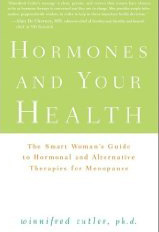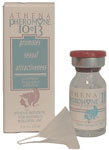
Chapter 12:
Your Changing Sexual Life and What You Can Do About It
"Look Inside" Dr. Winnifred Cutler's essential book; an excerpt from Chapter 12 for readers.
Click here for full book description
Copyright © 2009 John Wiley & Sons, Inc.
Hormones and Your Health: The Smart Woman's Guide to Hormonal and Alternative Therapies for Menopause
Excerpted pages 233, 236-237, 246, 254-255
Sexual well-being was correlated with overall happiness in both men and women of every culture and every location around the globe, according to a 2006 global study of more than 27,000 women and men who were 40 to 80 years of age.436
And sexual well-being inevitably changes. Sexual difficulties were some of the more frequently reported health concerns of menopausal women.202 The problems begin well before the last menstrual period. A decline in sexual responsiveness, frequency, and libido, with a significant increase in painful intercourse and partners’ performance problems are common.82, 200 These changes are most drastic for women who have pelvic surgery, but every woman can expect menopausal-related changes.
Factor in Our Culture
Clearly, culture plays a role in our attitudes toward aging and sexuality.83 Consider the U.S. movie industry’s preoccupation with youthful women paired to older men. Is this the mind-set of male Hollywood producers who—living in a movie star culture—are focused on short-term “arm candy” relationships that they glamorize in movies? Does it consign such young wives to become nursemaids and “first wives” to living out their mature years devoid of intimacy? Or consider polygamous cultures that replace old wives with secondary young wives: cultures that teach the older ones not to be sexual.490 Much of Western culture highly values long-term commitment to a partner who ages as you do. But keeping a rich intimate life may collide with the physiological realities of thinning vaginal tissue in menopause that can be vulnerable to abrasions, ulceration, and infection.
What’s a woman to do if she has, or wants to search for, a partner? Good studies offer useful insights to help you make some critical decisions.
Studying Sex
Studying sexual behavior research is not as simple as checking a woman’s blood pressure. Instead, the complexities include both partners’ physiology, attitudes, and skills. Even when one partner has a “dysfunction,” it is the couple’s sex life that is impaired.
For functional men, it’s straightforward and linear: they experience a stimulus, get erect, engage, move to the rhythm that “scratches their itch,” climax, and relax. Women are more complex, and their pattern is anything but linear; it’s almost circular, with on- and off-ramps at every stage. At every level, a woman’s heart and head are inextricably linked with her physical response.287
Sexual Desire
For many men, this sexual appetite or libido can easily dominate their experience.750 But women are more complex: desire covers a spectrum that ranges from aversion to disinclination, to indifference, to interest, to need, and, finally, to passion, wrote psychiatrist Steve Levine.448
His observations match other research. About 30 percent of women do not generally experience sexual desire. And unlike in men, in women desire follows genital arousal as often as the other way around.55, 57, 58 And for some postmenopausal women, sexuality has become irrelevant.
Desire Decreases with Time, Too
One study of young men and women in steady relationships found that for women, sexual desire decreases but the desire for tenderness increases as time passes. For men, sexual desire remained steady but the desire for tenderness decreased.405
A national social life survey of 3,200 U.S. residents, from 18 to 59 years old, likewise reported that the quality of marital sex declined with time for both men and women.458 Men seemed less sensitive to the problem. Women were less satisfied with sex in their marriages, maybe due to having fewer orgasms than their men had.
These disparities in long-term relationships create imbalances,148 but since sexual behavior is a partnership issue, these differences need to be negotiated.
An increase in sexual desire and sexual interest is consistently reported with a new relationship, even in women who are many years postmenopausal and with very low levels of sex hormones.58
The 2005 Study of Women’s Health Across the Nation confirmed that starting a new relationship is related to greater emotional satisfaction, sexual arousal, frequency of sexual intercourse, and desire.38 But whenever women began their perimenopausal changes, they were vulnerable to having an increase in painful intercourse because of hormonal changes. Even very young women, with plenty of estrogen, are vulnerable to sexual difficulties.518 For a more mature woman, her feeling for her partner is the key to sexual response.55, 58, 202
***
Estrogen Fuels Your Sex Life
For women, the capacity to respond genitally requires adequate estrogen that is equivalent to that of a menstruating fertile woman just before she is ovulating, to nourish the vaginal tissue as well as to enable the blood flow to that area.490
Why a low dose might not get you going. Dr. Dennerstein and her colleagues concluded that the low doses of estrogen that are promoted by some medical “authorities” would not be effective in sustaining a woman’s sexual function. I agree. For adequate sexual function, a woman needs levels of estrogen that are relatively high, or at least as high as when she was sexually active and comfortably so.203
What you should know: It was the circulating level of estrogen, not testosterone, that declinedconcomitantly with both the sexual interest and the sexual responsiveness in a cohort of healthy women who had not sought help for sexual dysfunction.203 Although a vital part of the sexual function equation is the behavior and skill of your male partner, there is no substitute for adequate circulating estrogen to preserve vaginal tissue from atrophying.
How estrogen helps. Dr. Norma McCoy focused a comprehensive review of the scientific research to show the relationships between estrogen therapy and sexuality, as listed below.507 Here is what she found.
- Vaginal dryness. Researchers reported that in 7 of 8 studies that examined vaginal dryness or vaginal cytologic (cell swabs) evidence, there were significant improvements with estrogen-replacement therapy, whether oral, transdermal, human, or conjugated equine estrogens.
- Dyspareunia. Only 1 of 6 reports was able to show improvement on hormone-replacement therapy; this one positive study used a structurally human estradiol-17b transdermally.
- Orgasm. Of 5 placebo-controlled studies, only 1 found a significant increase. That one used ethinyl estradiol at .05 mg, which is a very powerful synthetic estrogen that is not recommended because of its association with an increased risk of developing breast cancer and cardiovascular problems. (See chapters 9 and 10.) The other estrogens that were tested provided no help.
- Sexual interest (libido). Overall, 7 studies have allowed some tentative conclusions. In naturally menopausal women, structurally human estrogens can sometimes increase the women’s sexual interest, but conjugated equine estrogens like Premarin are not effective. Since the human forebrain has no receptors for most of the Premarin components (see table 3.2), this makes sense.
What a High-Quality Sexual Life Requires: Knowing Yourselves Respectfully
Aging undoubtedly influences sexuality. So does surgery. But researchers have found that mutual respect for the other person’s needs and wishes is key to a satisfying sexual life in every age group and becomes even more important as women age.317
A sensuous sex life requires self-knowledge and the unabashed ability to communicate your needs. For example, if a man moves to the rhythm of his own approach to orgasm and does not know that yours is different or changing, he may be well intended but may fail to engage you in the dance that leads to your orgasmic approach and release of tension.
The two key predictors of sexual satisfaction, according to research studies,599 in the age group 40 to 60 are:
- Whether a woman always experienced orgasm when she had intercourse and
- Whether she enjoyed embracing her partner.
If the answers to those two questions are “yes,” the women were sexually satisfied. Unfortunately, according to other research of more than 400 presumably healthy women between 35 and 59 years of age, less than 20 percent experienced orgasm on all occasions of sexual intercourse. The incidence of experiencing an orgasm during every intercourse begins to decline from a peak of 38 percent of women in their late thirties (if their pelvic organs are intact) and drops to about 21 percent of women by ages 55 to 60.321 I think it matters that women tell their partners what they need to experience orgasm. If you can experience orgasm every time he does, then you will be nourishing your intimate bond, securing its stability.
As estrogen levels decline with menopause or with surgical changes, both anatomy and physiology change. Some of these issues can be addressed with hormones, but not all. Sexual functioning in a woman is directly influenced by her feelings for the partner and by the partner’s sexual problems.204 Even so, by midlife, 40 percent of women have acknowledged that there had been a change in their sexual response in the last year.492 Many of the changes are normal, not dysfunctional. But both Big Pharma and certain physician specialists have an economic incentive to apply the “dysfunctional” label to that change. As a discerning consumer, you need unbiased facts to choose what’s best for you.
There are huge differences in findings between women who seek professional help for low sexual desire and those who answer “no problem” to questions about their sexuality. Women who have satisfying sex lives tend to report that their intimate lives improve with age; their satisfaction increases as they grow older in their relationships with partners they love. And their sexual satisfaction is dependent on their partners.317 This is not surprising since it takes cooperation from, and communication with, your partner in order to recognize and fulfill each other’s needs. There are two dancers, one dance.
Also in this chapter:
- Surgery and Sexuality – The Myth that Hysterectomy Improves Sex Life
- Which Hormones to consider for HRT
- Painful Intercourse and Related Problems
- Exercise and Sexuality
END OF EXCERPT
Dr. Cutler's pheromone science has been "bottled" into vials of unscented fragrance additives that increase wearers' sexual attractiveness. AVAILABLE FOR PURCHASE HERE

